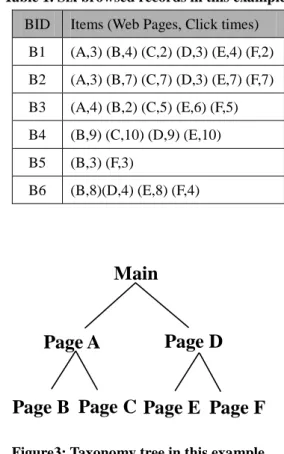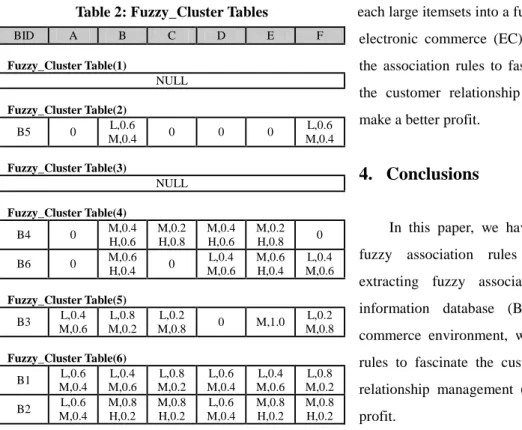Mining generalized fuzzy association rules from web pages
Yi-Tsung Tang, Master Student
Hung-Pin Chiu, Assistant Professor
Department of Information Management, NAN HUA University
Department of Information Management, National Taitung University
eric_tang630@hotmail.com
hpchiu@nttu.edu.tw
Abstract
The discovery of fuzzy association rules is an
important data-mining task for which many algorithms
have been proposed. However, the efficiency of these
algorithms needs to be improved to handle real-world
large datasets. In this paper, we present an efficient
method named cluster-based fuzzy association rule
(CBFAR) to discover generalized fuzzy association
rules from web pages. The CBFAR method is to create
fuzzy cluster tables by scanning the browse
information database (BIDB) once, and then clustering
the browse records to the k-th cluster table, where the
length of a record is k. The counts of the fuzzy regions
are stored in the Fuzzy_Cluster Tables. This method
requires less contrast to generate large itemsets. The
CBFAR method is also discussed.
Keyword:Fuzzy data mining; association rules
摘要
模糊關聯法則的挖掘是資料挖掘(Data Mining) 中一個重要的部分,也有許多的方法相繼被提出。 然而,這些演算法對於處理實際資料上的效率仍然 有改進的空間。本研究提出了一個有效率的方法 (Cluster-Based Fuzzy Association Rule:CBFAR)來 從許多網頁中找出模糊關聯法則,並改進挖掘的處 理效率,此方法以分群表(cluster table)的關念來儲 存網頁瀏覽次數之模糊值,在大項目組的產生過程 中,只需掃描瀏覽資料庫一次並去除許多不必要的 資料比對時間,有效的減少處理時間,改進效率。 關鍵詞:模糊資料挖掘、關聯法則
1. Introduction
The discovery of fuzzy association rules is an
important data-mining task. Association rules are used
to discover the relationships, and potential
associations, of items or attributes among huge data.
These rules can be effective in uncovering unknown
relationships, providing results that can be the basis of
forecast and decision.
Deriving association rules from transaction
database is most commonly seen in data mining. [2][4]
It discovers relationships among items. In the past,
Agrawal and Srikant proposed the Apriori association
rule algorithm.[5] It can discover meaningful itemsets
and construct association rules within large databases,
but a large number of the candidate itemsets are
generated from single itemsets. This method also
needs to perform contrasts against all of the
transactions, level by level, in the process of creating
association rules. The database is repeatedly scanned
to contrast each candidate itemset, that performance is
dramatically affected.
After Agrawal et al. proposed the Apriori
association rule, Tsay et al. have used cluster-based
association rule (CBAR) approach.[8] This method
used cluster-based table to reduce the number of
database scans and requiring less contrast. Recently,
the fuzzy set theory[3] has been used more and more
frequently in intelligent systems. It’s simplicity and
similarity to human reasoning.[1] Hong et al. also
proposed a fuzzy mining algorithm.[7] The items
relationships. However, items in real-world
applications are usually organized in some hierarchies.
Mining multiple-concept-level fuzzy rules may lead to
discovery of more general and important knowledge
from data.
In this paper, we present a new method called
cluster-based fuzzy association rule (CBFAR), for
efficient fuzzy association rules mining. We
considered the hierarchical relationships to discover
the generalized fuzzy association rules from the
browse information database (BIDB) and used the
cluster-based concept to reduce the number of
database scans. When the customer clicking the web
pages, then the click times stored in the browse
information database (BIDB).This method not only
needs only one database scans, but also requires less
contrast.
2. CBFAR Mining Framework
The hierarchical relationships and cluster-based
concepts are used to discover generalized fuzzy
association rules from browse information database
(BIDB). We propose a CBFAR mining framework for
discovering generalized fuzzy association rules. The
proposed framework is shown in Fig. 1.
We proposed mining framework maintains fuzzy
association rules, and uses the hierarchical
relationships and cluster-based fuzzy table to derive
the fuzzy association rules. Previous studies on data
mining focused on finding association rules on the
single-concept level. However, relevant web page
taxonomies are usually predefined in the networks
structure and can be represented using hierarchical
trees.[6] Terminal nodes on the trees represent actual
web pages appearing in networks structure; internal
nodes represent main or sub-main web pages formed
by lower-level nodes. A simple example is given in
Fig. 2.
In this example, the main page falls into two
sub-pages: page A and page D. Page A can be further
classified into page B and page C. Similarly, assume
page D are divided into page E and page F. The web
pages (A, B, C, D and E) can appear in browse
information records. The CBFAR mining method is
divided into four phases.
In the first phase, all of web pages in each given
browsed records are added according to the predefined
taxonomy.
In the second phase, transform the quantitative value v of each browsed dataij D (i=1 to n), for eachi
expanded item nameIj appearing into a fuzzy set
ij
f .The fij are represented as
( fij1/Rj1
+
fij2/Rj2+
+
fij1/R ) using the givenj1membership functions, where h is the number of fuzzy regions forI .j R is the lth fuzzy region ofjl I , 1j lh, and fijl is v ’ij s fuzzy membership value in region
jl
R . Calculate the value of each fuzzy region Rjl in
the browsed data. (
1 n jl ijl i count f
)In the third phase, creates M cluster tables. Scan
the browse information database once and cluster the
Page B Page C Page E Page F
Page A
Page D
Main
Figure2: An example of taxonomic structures
Fuzzy membership functions and web structure relationships Fuzzy Cluster_Table(1) … Fuzzy Cluster_Table(2) Fuzzy Cluster_Table(M)
Fuzzy Mining Fuzzy association rules Browse
Information DataBase
browsed data. If the length of browsed data is k, the
browsed record and the fuzzy region value of items in
this browsed record will be stored in the table, named
Fuzzy_Cluster Table (k), 1kM, where M is the length of the longest browsed record in database.
In the fourth phase, the set of candidate itemsets Cn is generated. When the length of
candidate itemset is k, the support is calculated with
reference to the Fuzzy_Cluster Table(k).If the fuzzy region value of Cn is greater than or equal to the
predefined minimum support value, the candidate itemsets becomes the large itemsets, put C in then
large itemsetsL . Otherwise, it is contrasted with then
Fuzzy_Cluster Table(k+1). The large itemsets is
max | max ,1
n j j
L R count j m . Until the large itemsets L is null, this process terminatesn
when the calculated support is greater than or equal to
the predefined minimum support or the the end of the
Fuzzy_Cluster Table(M) has been reached. Finally, use
the predefined minimum confidence value to discover
fuzzy association rules. If the candidate fuzzy
association rule is larger than or equal to the
predefined confidence value, put it in the rule base.
3. An Example
In this section, an example is given to illustrate
the proposed mining method. This is a simple example
to show how the proposed method can be used to
discover fuzzy association rules from browsed data.
There are six browsed records and five items (web
pages) in a browse information database: A, B, C, D,
E and F. An example browse information database is
shown in Table 1. The taxonomy tree is shown in Fig.
3. All of items (web pages) appearing in the browse
information database (BIDB) according to the
predefined taxonomy tree.
Table 1. Six browsed records in this example BID Items (Web Pages, Click times)
B1 (A,3) (B,4) (C,2) (D,3) (E,4) (F,2) B2 (A,3) (B,7) (C,7) (D,3) (E,7) (F,7) B3 (A,4) (B,2) (C,5) (E,6) (F,5) B4 (B,9) (C,10) (D,9) (E,10) B5 (B,3) (F,3) B6 (B,8)(D,4) (E,8) (F,4)
In this example, assume that the fuzzy
membership functions are the same for all the items
and are as shown in Fig. 4. The fuzzy membership
function is represented by three fuzzy regions: Low(L),
Middle(M) and High(H), and three fuzzy membership values are produced for each item according to the
predefined membership function.
The length of the longest browsed record in this
database is six, and creates six fuzzy_cluster tables as
shown in Table 2. The fuzzy region value of items in
this browsed record will be stored in the
Fuzzy_Cluster Tables.
Low
Middle
High
0
1
6
11
1
0
Figure4: The membership function in this example
Page B Page C Page E Page F
Page A
Page D
Main
Table 2: Fuzzy_Cluster Tables
Assume the minimum support value is 2.4. We can discover the Large-1 itemsets (L ) which is large1
than or equal to the predefined minimum support
value according to the fuzzy_cluster tables. The itemsets of L are {B.Middle = 3.0}, {E.Middle =1
3.2}, {F.Middle = 2.8}.
Generate the large 2-itemsetsL . Combining the2
items ofL in order to generate candidate 2-itemsets1
2
C . The procedure is similar to the candidate generation of Apriori algorithm[5]. The itemsets of
2
C are {B.Middle,E.Middle}, {B.Middle,F.Middle},
{E.Middle,F.Middle}. In order to generate L , it is2
necessary to compute the fuzzy region values of each
candidate itemset in the Fuzzy_Cluster Table(2). If the
value is larger than or equal to the predefined minimum support value, put C in the2 L . Otherwise,2
compute the fuzzy region values in the next cluster
table (Fuzzy_Cluster Table(3). The other large itemsetsL are in the similar way.n
Therefore, the large itemsets in this example are
{B.Middle},{E.Middle},{F.Middle},{B.Middle,E.Mid
dle},{E.Middle,F.Middle}. Then, we can transform
each large itemsets into a fuzzy association rule. In the
electronic commerce (EC) environment, we can use
the association rules to fascinate the customer. Then
the customer relationship management (CRM) can
make a better profit.
4. Conclusions
In this paper, we have proposed a generalized
fuzzy association rules mining framework for
extracting fuzzy association rules from browse
information database (BIDB). In the electronic
commerce environment, we can use the association
rules to fascinate the customer. Then the customer
relationship management (CRM) can make a better
profit.
The cluster-based fuzzy association rule (CBFAR)
method creates Fuzzy_Cluster Tables to discover the
large itemsets. Contrasts are performed only against
the partial Fuzzy_Cluster Tables that were created in
advance. It only requires a single scan of the browse
information database, and contrasts with the partial
Fuzzy_Cluster Tables. This method not only needs
only one database scans, but also requires less
contrast.
In the future, we will continuously for the huge
database, and discussing with the performance of
CBFAR method.
5. References
[1] A. Kandel, Fuzzy Expert Systems, CRC Press,
Boca Raton, FL, 1992, pp. 8-19.
[2] J. Han, Y. Fu, Discovery of multiple-level
association rules from large database, The Internet.
Conf. on Very Large Databases, 1995.
[3] L.A. Zadeh, Fuzzy sets, Inform. and Control 8(3),
1965 pp. 338-353.
[4] R.Agrawal, T. Imielinksi, A. Swami, Mining
BID A B C D E F Fuzzy_Cluster Table(1) NULL Fuzzy_Cluster Table(2) B5 0 L,0.6 M,0.4 0 0 0 L,0.6 M,0.4 Fuzzy_Cluster Table(3) NULL Fuzzy_Cluster Table(4) B4 0 M,0.4 H,0.6 M,0.2 H,0.8 M,0.4 H,0.6 M,0.2 H,0.8 0 B6 0 M,0.6 H,0.4 0 L,0.4 M,0.6 M,0.6 H,0.4 L,0.4 M,0.6 Fuzzy_Cluster Table(5) B3 L,0.4 M,0.6 L,0.8 M,0.2 L,0.2 M,0.8 0 M,1.0 L,0.2 M,0.8 Fuzzy_Cluster Table(6) B1 L,0.6 M,0.4 L,0.4 M,0.6 L,0.8 M,0.2 L,0.6 M,0.4 L,0.4 M,0.6 L,0.8 M,0.2 B2 L,0.6 M,0.4 M,0.8 H,0.2 M,0.8 H,0.2 L,0.6 M,0.4 M,0.8 H,0.2 M,0.8 H,0.2
association rules between sets of items in large
database, the 1993 ACM SIGMOD Conf.,
Washington, DC, USA, 1993.
[5] R. Agrawal, R. Srikant, Fast algorithm for mining
association rules in large databasaes, Proceedings
of 1994 International Conference on VLDB, 1994
pp. 487-499.
[6] R. Srikant, R. Agrawal, Mining generalized
association rules, The Internat. Conf. on Very
Large Databases, 1995.
[7] Tzung-Pei Hong, Kuei-Ying Lin, Shyue-Liang
Wang, Fuzzy data mining for interesting
generalized association rules, Fuzzy Sets and
Systems, 2003 pp. 255-269.
[8] Yuh-Jiuan Tsay, Jiunn-Yann Chiang, CBAR: an
efficient method for mining association rules,

